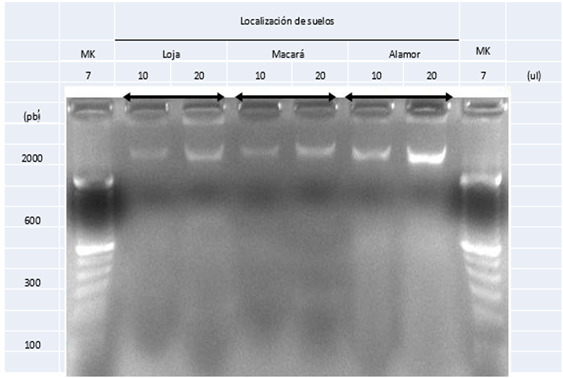Análisis del ADN ambiental en la determinación de la fertilidad del suelo agrícola en la provincia de Loja
DOI:
https://doi.org/10.18779/ingenio.v6i1.558Palabras clave:
Biomasa Bacteriana, Recuentos Bacterianos, Índice de Fertilidad del SueloResumen
La fertilidad del suelo se la puede determinar mediante diferentes procesos uno de estos es a través del análisis del ADN ambiental (eADN) el cual permite identificar la diversidad genética que se encuentran en dicho material, esencial en la formación y el mantenimiento de la productividad del suelo, este estudio, es el primero de su tipo en la provincia de Loja, se realizó mediante la selección de 9 áreas, en las cuales, se recogieron 26 muestras de suelo, se midió el eDNA y se estimó el número de microorganismos a partir de la cantidad de eDNA obtenido. El 35% de suelos totales (9) mostraron recuentos bacterianos mayores 6,0 x 108 células/g-suelo, el 15% (4) entre 2,0 x 108 células/g-suelo (recuentos bacterianos mínimos requeridos para la mineralización de compuestos orgánicos) y 6,0 x 108 células/g-suelo. Sin embargo, el 50% (13) restantes tenían menos de 2,0 x 108 células/g-suelo en estos suelos la mineralización con nitrógeno orgánico es extremadamente baja, encontrada en los cantones Saraguro, Paltas y Catamayo. Este estudio es importante porque identifica los recuentos bacterianos de diferentes suelos y la necesidad de incorporar microorganismos para mejorar rendimientos, gracias a la estandarización, la técnica se puede aplicar a la totalidad de los suelos de la provincia y del país.
Descargas
Citas
M. Kubo, M. Mukai, y D. Adhikari Construction of Soil Fertile Index (SOFIX) Based on Microorganisms and Application for Agriculture. Journal of Environmental Biotechnology, 15(2): 85-90 2016
A.C. Kennedy, Bacterial diversity in agroecosystems. Agriculture, Ecosystems & Environment. Elsevier volume 74: 65-76. 1999
A Sharpley, Agricultural phosphorus, water quality, and poultry production: are they compatible?. Poultry Science. Volume 78, Issue 5,1999, Pages 660-673
D. Rigby, D. Cáceres, Organic farming and the sustainability of agricultural systems. Agricultural Systems. Volume 68, Issue 1, 2001. Pages 21-40
P. Maeder, A. Fliessbach, D. Dubois, L. Gunst, P. Fried and U. Niggli. Soil fertility and biodiversity in organic farming. Science 296: 1694-1697. 2002
M.A. Tsiafouli, E. Thébault, S.P. Sgardelis, P.C de Ruiter, W.H. van der Putten, K .Birkhofer, L. Hemerik, F.T. de Vries, R.D. Bardgett, M.V. Brady, L. Bjornlund, H.B. Jørgensen, S. Christensen , T.D. Hertefeldt, S. Hotes, W.H. Gera Hol, J. Frouz, M. Liiri, SR Mortimer, H. Setälä, J. Tzanopoulos, K. Uteseny, V. Pižl, J. Stary, V.Wolters, K. Hedlund. Intensive agriculture reduces soil biodiversity across Europe. Glob Chang Biol. Feb;21(2):973-85 2015
R.J. Stirzaker, J.B. Passioura & Y. Wilms. Soil structure and plant growth: Impact of bulk density and biopores. Plant Soil 185, 151–162. 1996
E.K. Bünemann, L.M. Condron. Phosphorus and Sulphur Cycling in Terrestrial Ecosystems. In: Marschner, P., Rengel, Z. (eds) Nutrient Cycling in Terrestrial Ecosystems. Soil Biology, vol 10. Springer, Berlin, Heidelberg. vol. 10. Springer. 2007
H.W. Scherer. Sulfur in soils. Journal of Plant Nutrition and Soil Sci, 172(3): 326-335. 2009.
R. Martens. Current methods for measuring microbial biomass C in soil: Potentials and limitations. Biol Fertil Soils 19, 87–99. 1995
M.E. Arias, J.A. González-Pérez, F.J. González-Vila, y A.S. Ball. Soil health—a new challenge for microbiologists and chemists. Int Microbiol, 8(1): 13-21. 2005.
S. Tsuji, M. Ushio, S. Sakurai, T. Minamoto, y H. Yamanaka Water temperature- dependent degradation of environmental DNA and its relation to bacterial abundance. PLoS One, 12(4): e0176608. 2017
H. Aoshima, A. Kimura, A. Shibutani, C. Okada, Y. Matsumiya, M. Kubo. Evaluation of soil bacterial biomass using environmental DNA extracted by slow-stirring method. Appl Microbiol Biotechnol. Aug;71(6):875-80. 2006
D. N. Miller, J.E. Bryant, E.L. Madsen, y W.C. Ghiorse. Evaluation and optimization of DNA extraction and purification procedures for soil and sediment samples. Appl Environ Microbiol, 65(11): 4715-4724. 1999
J. Gans, M. Wolinsky, y J. Dunbar. Computational improvements reveal great bacterial diversity and high metal toxicity in soil. Science, 309(5739): 1387-1390. 2005
M. Kimura. Microbial World Acting in Soil (9) -Microorganisms in Grassland-. J. the Japanese Irrigation, Drainage and Reclamation Engineering, 59(12): 1413-1421. 1991.
H. Doi, R. Inui, Y. Akamatsu, K. Kanno, H. Yamanaka, T. Takahara, y T. Minamoto. Environmental DNA analysis for estimating the abundance and biomass of stream fish. Freshwater Biol, 62(1): 30-39. 2017.
J. Zhou, M.A. Bruns, y J.M. Tiedje. DNA Recovery from Soils of Diverse Composition. Appl Environ Microbiol, 62(2): 316-322. 1996
Y. Fukuhara, S. Horii, T. Matsuno, Y. Matsumiya, M. Mukai, y M. Kubo. Distribution of hydrocarbon-degrading bacteria in the soil environment and their contribution to bioremediation. Appl Biochem Biotechnol, 170(2): 329-339. 2013
S. Horii, T. Matsuno, J. Tagomori, M. Mukai, D. Adhikari, y M. Kubo. Isolation and identification of phytate-degrading bacteria and their contribution to phytate mineralization in soil. J Gen Appl Microbiol, 59(5): 353-360. 2013.

Publicado
Cómo citar
Número
Sección
Licencia
Derechos de autor 2023 Masao Nishikawa, Franklin Román Cárdenas, Miguel Marín-Gómez

Esta obra está bajo una licencia internacional Creative Commons Atribución-NoComercial-CompartirIgual 4.0.
Licensing Agreement
This journal provides free access to its content through its website following the principle that making research available free of charge to the public supports a larger exchange of global knowledge.
Web content of the journal is distributed under a Attribution-NonCommercial-ShareAlike 4.0 International.
Authors may adopt other non-exclusive license agreements for the distribution of the version of the published work, provided that the initial publication in this journal is indicated. Authors are allowed and recommended to disseminate their work through the internet before and during the submission process, which can produce interesting exchanges and increase citations of the published work.











